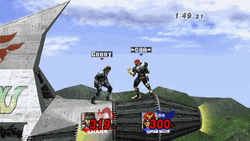Smash directional influence
Smash directional influence, also known as Smash DI or SDI, is a mechanic that allows players to slightly alter their position during the freeze frames of being hit by an attack. Tapping the control stick or C-Stick in any direction during freeze frames will slightly move their character in that direction, allowing them to potentially escape multi-hit moves or certain combos. SDI can also be used to move into a wall or ceiling in order to tech near-instantly (and is also possible with floors if the character starts in the air) or to (very minimally) increase the distance from the blast line that the attack is about to send them towards.
Despite its near-identical name, SDI is not a subtype of directional influence, but a different mechanic altogether that is performable under the same circumstances. The major difference is that, while DI changes the trajectory a character is launched in, SDI changes a character's position before launch. DI also does not exist in the original Super Smash Bros., while SDI does.
The mechanics of SDI operate by shifting the character in a given direction if a new directional vector of sufficient size is input on that frame. As a result, repeatedly tapping in one direction will move the character much farther than simply holding the stick in that direction. In addition, because diagonals are considered to be two vectors, changing from an orthogonal position to an adjacent diagonal one will generate a new SDI "pulse", while changing from a diagonal position to an adjacent orthogonal one will not. This results in a technique called quarter-circle DI, which involves quickly rotating the stick between two orthagonal positions for increased distance. Quarter-circle DI was introduced to the United States by smasher Captain Jack and was once known as Japanese DI.
As the C-Stick can also be used for SDI, even "stronger" forms of SDI exist. So-called double-stick DI utilizes the C-Stick's ability to override the control stick by holding one of the sticks in one direction and utilizing quarter-stick DI with the other.
Automatic smash directional influence is a weaker variant of SDI. Once a character's freeze frames are over, they shift slightly in whatever direction the control stick is currently held, slightly less than one SDI input. If the C-Stick is also being held in a direction, it will override the control stick's input. ASDI is significantly less useful than regular SDI and is generally ignored and any stick position during this time is likely to be attempt at regular DI.
Beginning in Brawl, several attacks have an SDI multiplier attached to them, which affects how far opponents are able to SDI when hit by them. For example, the looping hits of Mario's down aerial have an SDI multiplier of 1.5, making it easier than usual to escape the attack, while the sweetspot of the Knee Smash has an SDI multiplier of zero, so SDI'ing it is impossible.
